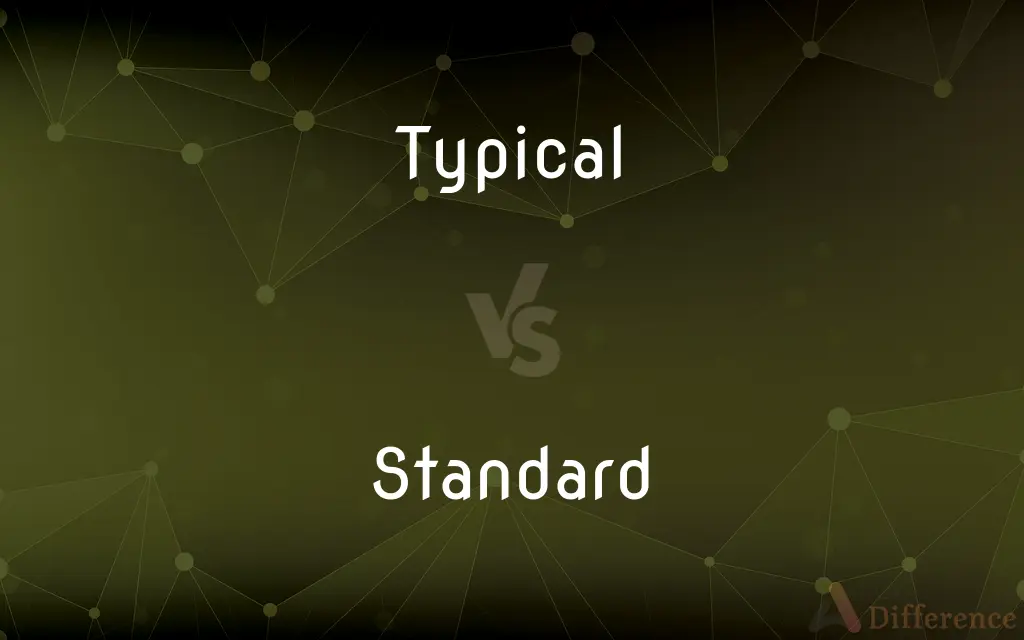Typical vs. Standard — What's the Difference?
By Fiza Rafique & Maham Liaqat — Updated on April 4, 2024
Typical refers to what is usual or expected in a specific context, while standard denotes a level of quality or a norm that has been officially agreed upon.

Difference Between Typical and Standard
Table of Contents
ADVERTISEMENT
Key Differences
The term "typical" is often used to describe what is common or usual within a certain context. For instance, a typical day might involve routine activities like working 9 to 5, whereas what is considered typical can vary widely from one culture or individual to another. On the other hand, "standard" refers to a specific level of quality or achievement that has been established as a benchmark. Standards are often set by authorities or consensus in various fields to ensure consistency and quality, such as the standard measurements in construction or the standard protocols in data communication.
While typicality is about what is commonly observed or expected based on experience or statistical norms, standards involve a degree of formalization and are used as a reference point for comparison, compliance, or measurement. For example, a typical smartphone might have a certain range of features that most consumers expect, while the standard for wireless communication among devices is precisely defined by technical specifications that manufacturers agree to follow.
The concept of being typical is more subjective and can vary depending on the observer's perspective, context, and experience. In contrast, standards are objective and established through a formal process by governing bodies, industries, or consensus among stakeholders. Thus, while something typical can provide insight into common practices or trends, a standard serves as a definitive guide for expected practices, quality, or performance.
Standards play a critical role in ensuring safety, interoperability, and efficiency in various industries. They can dictate the minimum quality of materials, the protocol for data encryption, or the safety measures for construction. Typical behaviors or practices, however, might not always meet these standards, highlighting a gap between what is commonly done and what should be done according to established benchmarks.
Both terms can be applied across diverse fields, including technology, business, culture, and everyday life, their implications for decision-making and assessment vary significantly. Understanding whether a reference is to what is typical or to a standard can influence expectations, planning, and evaluation of outcomes in any given scenario.
ADVERTISEMENT
Comparison Chart
Definition
Common or usual in a specific context.
An agreed-upon level of quality or norm.
Nature
Subjective and variable.
Objective and fixed.
Establishment
Based on observation or experience.
Formally set by authorities or consensus.
Purpose
To describe what is generally seen or expected.
To ensure consistency and quality.
Application
Varies by context, culture, and individual.
Applies universally within its scope.
Compare with Definitions
Typical
Showing the characteristics expected of or popularly associated with a particular person, situation, or thing.
A typical example of medieval architecture.
Standard
Principles for ensuring that products, services, and methods are fit for their purpose.
The ISO 9001 standard specifies requirements for quality management systems.
Typical
Occurring naturally.
The typical colors of fall foliage are orange and red.
Standard
A rule or principle that is used as a basis for judgment.
They set new standards for behavior among students.
Typical
Normal for a specific person to do.
It’s typical of him to arrive late.
Standard
An idea or thing used as a measure, norm, or model in comparative evaluations.
Gold is the standard for measuring wealth.
Typical
Representative of a type or group.
She displayed the typical symptoms of the flu.
Standard
The degree of excellence required for a particular purpose.
The standard of proof in criminal law is beyond a reasonable doubt.
Typical
Characteristic of a particular person, place, or thing.
Wearing a suit is typical attire for his office.
Standard
A level of quality or attainment
The government's ambition to raise standards in schools
Their restaurant offers a high standard of service
Typical
Exhibiting the qualities, traits, or characteristics that identify a kind, class, group, or category
A typical suburban community.
Standard
Something used as a measure, norm, or model in comparative evaluations
The wages are low by today's standards
The system had become an industry standard
Typical
Of or relating to a representative specimen; characteristic or distinctive.
Standard
(especially with reference to jazz or blues) a tune or song of established popularity.
Typical
Conforming to a type
A composition typical of the baroque period.
Standard
A military or ceremonial flag carried on a pole or hoisted on a rope.
Typical
Also typ·ic (-ĭk) Of the nature of, constituting, or serving as a type; emblematic.
Standard
A tree or shrub that grows on an erect stem of full height.
Typical
Conforming with what usually happens
The bus is late again? That's so typical!.
Standard
An upright water or gas pipe.
Typical
Capturing the overall sense of a thing.
Standard
Used or accepted as normal or average
It is standard practice in museums to register objects as they are acquired
The standard rate of income tax
Typical
Characteristically representing something by form, group, idea or type.
Standard
(of a tree or shrub) growing on an erect stem of full height
Standard trees are useful for situations where immediate height is needed
Typical
Normal, average; to be expected.
Standard
Serving as or conforming to an established or accepted measurement or value
A standard unit of volume.
Typical
(taxonomy) Of a lower taxon, containing the type of the higher taxon.
Standard
Widely recognized or employed as a model of authority or excellence
A standard reference work.
Typical
Anything that is typical, normal, or standard.
Antipsychotic drugs can be divided into typicals and atypicals.
Among the moths, typicals were more common than melanics.
Standard
Acceptable but of less than top quality
A standard grade of beef.
Typical
Of the nature of a type; representing something by a form, model, or resemblance; emblematic; prefigurative.
The Levitical priesthood was only typical of the Christian.
Standard
Normal, familiar, or usual
The standard excuse.
Typical
Combining or exhibiting the essential characteristics of a group; as, a typical genus.
Standard
Commonly used or supplied
Standard car equipment.
Typical
Exhibiting the qualities or characteristics that identify a group or kind or category;
A typical American girl
A typical suburban community
The typical car owner drives 10,000 miles a year
A painting typical of the Impressionist school
A typical romantic poem
A typical case of arteritis
Standard
(Linguistics) Conforming to models or norms of usage admired by educated speakers and writers
Standard pronunciation.
Typical
Of a feature that helps to distinguish a person or thing;
Jerusalem has a distinctive Middle East flavor
That is typical of you!
Standard
An acknowledged measure of comparison for quantitative or qualitative value; a criterion.
Typical
Conforming to a type;
The typical (or normal) American
Typical teenage behavior
Standard
An object that under specified conditions defines, represents, or records the magnitude of a unit.
Standard
The commodity or commodities used to back a monetary system.
Standard
The set proportion by weight of gold or silver to alloy metal prescribed for use in coinage.
Standard
A degree or level of requirement, excellence, or attainment
Their quality of work exceeds the standards set for the field.
Standard
Something, such as a practice or a product, that is widely recognized or employed, especially because of its excellence.
Standard
A set of specifications that are adopted within an industry to allow compatibility between products.
Standard
A requirement of moral conduct
The standards of polite society.
Standard
The ensign of a chief of state, nation, or city.
Standard
A long, tapering flag bearing heraldic devices distinctive of a person or corporation.
Standard
An emblem or flag of an army, raised on a pole to indicate the rallying point in battle.
Standard
The colors of a mounted or motorized military unit.
Standard
Chiefly British A grade level in elementary schools.
Standard
A pedestal, stand, or base.
Standard
The large upper petal of the flower of a pea or related plant. Also called banner, vexillum.
Standard
One of the narrow upright petals of an iris.
Standard
A shrub or small tree that through grafting or training has a single stem of limited height with a crown of leaves and flowers at its apex.
Standard
(Music) A composition that is continually used in repertoires
A pianist who knew dozens of Broadway standards.
Standard
Falling within an accepted range of size, amount, power, quality, etc.
Standard
(of a tree or shrub) Growing alone as a free-standing plant; not trained on a post etc.
Standard
Having recognized excellence or authority.
Standard works in history; standard authors
Standard
Of a usable or serviceable grade or quality.
Standard
Having a manual transmission.
Standard
As normally supplied (not optional).
Standard
(linguistics) Conforming to the standard variety.
Standard
A principle or example or measure used for comparison.
Standard
A level of quality or attainment.
Standard
Something used as a measure for comparative evaluations; a model.
Standard
A musical work of established popularity.
Standard
A rule or set of rules or requirements which are widely agreed upon or imposed by government.
Standard
The proportion of weights of fine metal and alloy established for coinage.
Standard
(sociolinguistics) standard idiom, a prestigious or standardized language variety; standard language
Standard
A bottle of wine containing 0.750 liters of fluid.
Standard
(India) Grade level in primary education.
I am in fifth standard.
Standard
A vertical pole with something at its apex.
Standard
An object supported in an upright position, such as a lamp standard.
Standard
The flag or ensign carried by a military unit.
Standard
One of the upright members that supports the horizontal axis of a transit or theodolite.
Standard
Any upright support, such as one of the poles of a scaffold.
Standard
A sturdy, woody plant whose upright stem is used to graft a less hardy ornamental flowering plant on, rather then actually planting it.
Standard
A tree of natural size supported by its own stem, and not dwarfed by grafting on the stock of a smaller species nor trained upon a wall or trellis.
Standard
The sheth of a plough.
Standard
A manual transmission vehicle.
Standard
(botany) The upper petal or banner of a papilionaceous corolla.
Standard
(shipbuilding) An inverted knee timber placed upon the deck instead of beneath it, with its vertical branch turned upward from that which lies horizontally.
Standard
A large drinking cup.
Standard
(historical) A collar of mail protecting the neck.
Standard
(slang) An expression of agreement
Standard
A flag; colors; a banner; especially, a national or other ensign.
His armies, in the following day,On those fair plains their standards proud display.
Standard
That which is established by authority as a rule for the measure of quantity, extent, value, or quality; esp., the original specimen weight or measure sanctioned by government, as the standard pound, gallon, or yard.
Standard
That which is established as a rule or model by authority, custom, or general consent; criterion; test.
The court, which used to be the standard of propriety and correctness of speech.
A disposition to preserve, and an ability to improve, taken together, would be my standard of a statesman.
Standard
The proportion of weights of fine metal and alloy established by authority.
By the present standard of the coinage, sixty-two shillings is coined out of one pound weight of silver.
Standard
A tree of natural size supported by its own stem, and not dwarfed by grafting on the stock of a smaller species nor trained upon a wall or trellis.
In France part of their gardens is laid out for flowers, others for fruits; some standards, some against walls.
Standard
The upper petal or banner of a papilionaceous corolla.
Standard
An upright support, as one of the poles of a scaffold; any upright in framing.
Standard
An inverted knee timber placed upon the deck instead of beneath it, with its vertical branch turned upward from that which lies horizontally.
Standard
The sheth of a plow.
Standard
A large drinking cup.
Standard
Being, affording, or according with, a standard for comparison and judgment; as, standard time; standard weights and measures; a standard authority as to nautical terms; standard gold or silver.
Standard
Hence: Having a recognized and permanent value; as, standard works in history; standard authors.
Standard
Not supported by, or fastened to, a wall; as, standard fruit trees.
Standard
A basis for comparison; a reference point against which other things can be evaluated;
They set the measure for all subsequent work
Standard
The ideal in terms of which something can be judged;
They live by the standards of their community
Standard
A board measure = 1980 board feet
Standard
The value behind the money in a monetary system
Standard
An upright pole or beam (especially one used as a support);
Distance was marked by standards every mile
Lamps supported on standards provided illumination
Standard
Any distinctive flag
Standard
Conforming to or constituting a standard of measurement or value; or of the usual or regularized or accepted kind;
Windows of standard width
Standard sizes
The standard fixtures
Standard brands
Standard operating procedure
Standard
Commonly used or supplied;
Standard procedure
Standard car equipment
Standard
Established or widely recognized as a model of authority or excellence;
A standard reference work
Standard
Conforming to the established language usage of educated native speakers;
Standard English
Received standard English is sometimes called the King's English
Common Curiosities
How is a "standard" established?
A standard is established through formal processes by authoritative bodies, industry groups, or by consensus among stakeholders.
Why are standards important?
They ensure consistency, quality, safety, and interoperability across various industries and disciplines.
Is it possible for standards to become outdated?
Yes, as technology and practices evolve, standards may need to be revised or replaced to remain relevant and effective.
Does the definition of "typical" change over time?
Yes, what is considered typical can change based on evolving trends, cultural shifts, and new technological advancements.
How do standards affect consumer products?
Standards ensure that products meet specific safety, quality, and performance requirements, protecting consumers and enabling compatibility.
What is the role of standards in technology?
They facilitate compatibility, interoperability, and safety in the development and use of technological products and services.
Can a new product set a new standard?
Yes, innovative products can establish new benchmarks for quality, performance, or functionality, effectively setting new standards in their field.
What does "typical" imply in everyday language?
It implies something that is usual or expected based on common occurrences or general experience.
How can one determine what is typical for a specific situation?
Through observation, research, or statistical analysis of what commonly occurs or is expected in that situation.
Can standards vary by country or industry?
Yes, standards can vary significantly across different countries and industries, although there are efforts to harmonize some standards internationally.
Are there legal implications for not meeting standards?
Yes, failing to meet certain standards, especially those related to safety and health, can result in legal action and liability.
Can something be typical but not meet the standard?
Yes, something can be commonly observed (typical) but not meet the established benchmarks or standards of quality or performance.
How does something become typical in a culture?
Through frequent occurrence or widespread acceptance and practice within the culture over time.
Why might a company choose to exceed industry standards?
To differentiate their products or services, enhance brand reputation, or offer superior quality and performance to consumers.
What happens when a product or service does not meet established standards?
It may face regulatory penalties, be withdrawn from the market, or suffer from poor consumer reception and sales.
Share Your Discovery

Previous Comparison
Realize vs. Recognize
Next Comparison
Dab vs. DapAuthor Spotlight
Written by
Fiza RafiqueFiza Rafique is a skilled content writer at AskDifference.com, where she meticulously refines and enhances written pieces. Drawing from her vast editorial expertise, Fiza ensures clarity, accuracy, and precision in every article. Passionate about language, she continually seeks to elevate the quality of content for readers worldwide.
Co-written by
Maham Liaqat












































